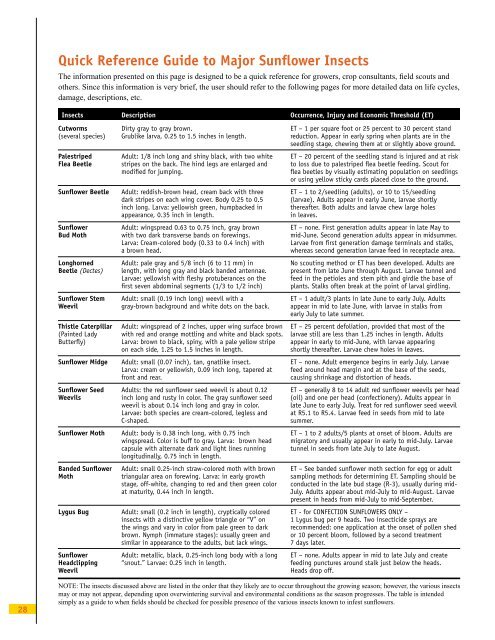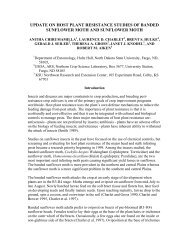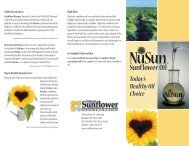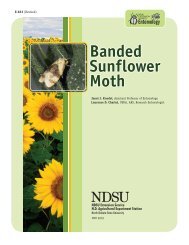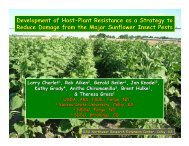Sunflower Production - NDSU Agriculture - North Dakota State ...
Sunflower Production - NDSU Agriculture - North Dakota State ...
Sunflower Production - NDSU Agriculture - North Dakota State ...
You also want an ePaper? Increase the reach of your titles
YUMPU automatically turns print PDFs into web optimized ePapers that Google loves.
Quick Reference Guide to Major <strong>Sunflower</strong> InsectsThe information presented on this page is designed to be a quick reference for growers, crop consultants, field scouts andothers. Since this information is very brief, the user should refer to the following pages for more detailed data on life cycles,damage, descriptions, etc.Insects Description Occurrence, Injury and Economic Threshold (ET)Cutworms Dirty gray to gray brown. ET – 1 per square foot or 25 percent to 30 percent stand(several species) Grublike larva, 0.25 to 1.5 inches in length. reduction. Appear in early spring when plants are in theseedling stage, chewing them at or slightly above ground.Palestriped Adult: 1/8 inch long and shiny black, with two white ET – 20 percent of the seedling stand is injured and at riskFlea Beetle stripes on the back. The hind legs are enlarged and to loss due to palestriped flea beetle feeding. Scout formodified for jumping.flea beetles by visually estimating population on seedlingsor using yellow sticky cards placed close to the ground.<strong>Sunflower</strong> Beetle Adult: reddish-brown head, cream back with three ET – 1 to 2/seedling (adults), or 10 to 15/seedlingdark stripes on each wing cover. Body 0.25 to 0.5 (larvae). Adults appear in early June, larvae shortlyinch long. Larva: yellowish green, humpbacked in thereafter. Both adults and larvae chew large holesappearance, 0.35 inch in length.in leaves.<strong>Sunflower</strong> Adult: wingspread 0.63 to 0.75 inch, gray brown ET – none. First generation adults appear in late May toBud Moth with two dark transverse bands on forewings. mid-June. Second generation adults appear in midsummer.Larva: Cream-colored body (0.33 to 0.4 inch) with Larvae from first generation damage terminals and stalks,a brown head.whereas second generation larvae feed in receptacle area.Longhorned Adult: pale gray and 5/8 inch (6 to 11 mm) in No scouting method or ET has been developed. Adults areBeetle (Dectes) length, with long gray and black banded antennae. present from late June through August. Larvae tunnel andLarvae: yellowish with fleshy protuberances on the feed in the petioles and stem pith and girdle the base offirst seven abdominal segments (1/3 to 1/2 inch) plants. Stalks often break at the point of larval girdling.<strong>Sunflower</strong> Stem Adult: small (0.19 inch long) weevil with a ET – 1 adult/3 plants in late June to early July. AdultsWeevil gray-brown background and white dots on the back. appear in mid to late June, with larvae in stalks fromearly July to late summer.Thistle Caterpillar Adult: wingspread of 2 inches, upper wing surface brown ET – 25 percent defoliation, provided that most of the(Painted Lady with red and orange mottling and white and black spots. larvae still are less than 1.25 inches in length. AdultsButterfly) Larva: brown to black, spiny, with a pale yellow stripe appear in early to mid-June, with larvae appearingon each side, 1.25 to 1.5 inches in length.shortly thereafter. Larvae chew holes in leaves.<strong>Sunflower</strong> Midge Adult: small (0.07 inch), tan, gnatlike insect. ET – none. Adult emergence begins in early July. LarvaeLarva: cream or yellowish, 0.09 inch long, tapered at feed around head margin and at the base of the seeds,front and rear.causing shrinkage and distortion of heads.<strong>Sunflower</strong> Seed Adults: the red sunflower seed weevil is about 0.12 ET – generally 8 to 14 adult red sunflower weevils per headWeevils inch long and rusty in color. The gray sunflower seed (oil) and one per head (confectionery). Adults appear inweevil is about 0.14 inch long and gray in color. late June to early July. Treat for red sunflower seed weevilLarvae: both species are cream-colored, legless and at R5.1 to R5.4. Larvae feed in seeds from mid to lateC-shaped.summer.<strong>Sunflower</strong> Moth Adult: body is 0.38 inch long, with 0.75 inch ET – 1 to 2 adults/5 plants at onset of bloom. Adults arewingspread. Color is buff to gray. Larva: brown head migratory and usually appear in early to mid-July. Larvaecapsule with alternate dark and light lines running tunnel in seeds from late July to late August.longitudinally, 0.75 inch in length.Banded <strong>Sunflower</strong> Adult: small 0.25-inch straw-colored moth with brown ET – See banded sunflower moth section for egg or adultMoth triangular area on forewing. Larva: in early growth sampling methods for determining ET. Sampling should beconducted in the late bud stage (R-3), usually during mid-July. Adults appear about mid-July to mid-August. Larvaepresent in heads from mid-July to mid-September.stage, off-white, changing to red and then green colorat maturity, 0.44 inch in length.Lygus Bug Adult: small (0.2 inch in length), cryptically colored ET - for CONFECTION SUNFLOWERS ONLY –insects with a distinctive yellow triangle or “V” on 1 Lygus bug per 9 heads. Two insecticide sprays arethe wings and vary in color from pale green to dark recommended: one application at the onset of pollen shedbrown. Nymph (immature stages): usually green and or 10 percent bloom, followed by a second treatmentsimilar in appearance to the adults, but lack wings. 7 days later.<strong>Sunflower</strong> Adult: metallic, black, 0.25-inch long body with a long ET – none. Adults appear in mid to late July and createHeadclipping “snout.” Larvae: 0.25 inch in length. feeding punctures around stalk just below the heads.WeevilHeads drop off.28NOTE: The insects discussed above are listed in the order that they likely are to occur throughout the growing season; however, the various insectsmay or may not appear, depending upon overwintering survival and environmental conditions as the season progresses. The table is intendedsimply as a guide to when fields should be checked for possible presence of the various insects known to infest sunflowers.


